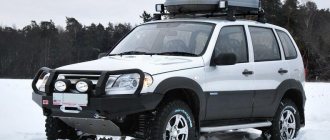AvtoVAZ cars are among the most popular in the domestic car market. They are distinguished from foreign brands by their affordable price and moderate fuel consumption. Engineers and designers of the Tolyatti Automobile Plant have developed several generations of the Lada brand, providing buyers with a choice depending on visual and price preferences. But one of the main arguments when buying a car is its “gluttony” and, accordingly, the cost of filling a full tank.
In practically all Lad models, fuel consumption per 100 km does not exceed 10 liters, but the exact data depends on many parameters. These include:
- The model of car;
- engine capacity;
- aerodynamic performance;
- technical serviceability (condition of the engine, spark plugs, injector, filters, etc.);
- type of fuel (gasoline, diesel, gas);
- time of year (in winter these indicators are higher than in summer);
- driver's driving style;
- place of operation (driving outside the city is more economical than within its boundaries);
- condition of the roadway;
- weather.
Today AvtoVAZ can offer potential buyers several Lada variants at once, having previously agreed on the material capabilities and technical needs of future car owners. Below we present the characteristics of the most popular models, and in the tables below them - the average fuel consumption of a Lada car per 100 km (A-95 gasoline is used as the basis, the unit of measurement is liter) when driving in the urban cycle, outside the city and in the mixed cycle. But the real performance of a particular car can only be established experimentally, having covered dozens of kilometers.
Fuel consumption indicators for different engines: norm and real data
How much the machine should “eat” according to the norm is stated in the technical documents. But in fact, the real numbers are always different. This difference is made up of the following factors:
- vehicle weight;
- engine capacity;
- driving style;
- driving conditions: highway or city;
- drive unit.
It is important to note that the passport standard is practically unattainable. A positive option for any car is when the car consumes no more than 10-15% more than what is indicated in the documentation per hundred kilometers.
Lada Vesta VAZ-21129 (1.6)
The initial and most popular type of engine for the Lada Vesta is a 1.6 liter 106 horsepower engine with 10 valves. There are two options for such models: they can be equipped with both mechanics and automatic transmission. This will significantly affect fuel costs. The official website contains standards that have been tested in laboratory conditions and are not related to operational figures. In practice, these figures are always slightly higher.
With engine 1.6 manual
The consumption standards for a manual gearbox in the car's passport are as follows:
- for driving in urban areas – 9.4 liters per hundred km;
- for driving on a flat country road – 5.7 liters for the same distance;
- when mixing driving cycles - 6.8 liters.
In reality, indicators for mechanics:
- driving in urban areas - 10.4 liters;
- on a country road - 6.4 l;
- when mixing driving types - 8.1 liters.
If the driver is accustomed to smooth control, then the fuel cost parameters will always be slightly lower than when driving with constant braking and a sharp start.
With engine 1.6 Robot
Costs, both standard and actual, are slightly lower with automation. Passport indicators:
- urban conditions - 8.9 liters per 100 km;
- road outside the city – 5.3;
- when mixed - 6.6 l.
Real figures: for the city 9.9 liters, for the highway - 6.2 liters, and with mixed driving - 7.5 liters.
This is with good driving, without taking into account additional factors. On average, Lada Vesta “eats” 8–10 liters per 100 km with a 1.6 engine.
Owner reviews about fuel consumption of Lada Vesta 1.6 106
Lada Vesta VAZ-21179 (1.8)
The VAZ-21179 engine was released recently, and it powers the station wagon. Engine indicators:
- 1.8 liters;
- power parameters – 122.5 horsepower;
- 4 cylinders;
- compression level – 9.
When moving around the city, the maximum consumption for such an engine is 11 liters per hundred km. But the details also depend on the gearbox.
With 1.8 manual engine
Indicators for mechanics according to the passport:
- in the city - 11 liters;
- outside the city – 6 l;
- mixed driving – 7 l.
In reality, a manual with such an engine consumes from 8–12 liters, depending on driving conditions.
With engine 1.8 Robot
The machine spends less:
- in the city - 10 l;
- outside urban conditions – 5.5;
- mixed driving – 6.5.
In fact, the figures range from 7 to 11 liters per 100 km.
Owner reviews about fuel consumption of Lada Vesta 1.8
Lada Vesta HR16DE (1.6)
The foreign version of the 1.6 liter engine has 117 horses. With the same volume as the VAZ-21129, the foreign engine has more power. They are not adapted for automatic, there is only a mechanical option. Standard fuel consumption indicators for this engine:
- in the city - 8 liters per 100 km;
- on the highway - 5 liters per 100 km;
- with mixed driving – 6 liters per 100 km.
In fact, the Lada Vesta HR16DE consumes 6–9 liters. It is permissible to refuel such a car with methane, which is much cheaper in terms of costs.
Advantages • Gasoline quality
| Grant fuel consumption at idle And there is nothing surprising here, when the temperature of a running engine changes, the processes of mixture formation and combustion of the fuel mixture also undergo changes. Installing 4 valves per cylinder made it possible to reduce the load on the engine, which had a positive effect on reducing fuel consumption and at the same time increasing the power of the power unit. |
- for urban traffic: from 7.1 to 19.6 liters at maximum, and on average - 11.8 liters;
- extra-urban cycle (highway traffic): from 6.0 to 10.2 liters, which on average equates to 7.6 liters;
- in mixed mode (city-highway): from 7.2 to 14.8 liters, or an average value of 10.3 liters.
Statistics of fuel consumption on different Lada Vesta models
Lada Vesta has a number of different models. Depending on the configuration and the vehicle itself, the average fuel consumption figures also change.
| Lada Vesta model | Fuel consumption, l/100 km | |
| Document costs | Real numbers | |
| SW 1.6 | 5.7-9.2 | 6.5-10 |
| Cross Lux | 8-11 | 8.5-12 |
| SV Cross | 7.4-10.7 | 8-11.5 |
| SV 1.8 | 6-10 | 7-11 |
The world's main methods for measuring the consumption of new cars
Instead of a new car, a run-in version of the tested model can be used and almost perfect conditions created for this: the windows are closed, the air conditioning, headlights and MMC are turned off, etc. Another advantage can be considered that the test duration is 1874 seconds, so it is more difficult for hybrid car models to show unrealistically low fuel consumption indicators.
Reasons for high gas consumption
If fuel consumption differs from the passport values by more than 30%, you need to go for diagnostics. There may be several reasons for increased fuel costs:
- Incorrect, too harsh driving style, with sharp braking and instant acceleration.
- Poor quality gasoline.
- Poor performance of the power unit and its components.
- Negative temperatures, driving on winter roads.
- Constant operation of the heater, air conditioner and other devices in the cabin.
If you operate the car correctly, you can get as close as possible to the indicators that are in the documents.
Principles of fuel economy © Driving style
| Lada Granta in detail about fuel consumption If the lever-type fuel level sensor does not correctly indicate the fuel level, then the reason associated with the potentiometer and causing this malfunction may be as follows. With this method of determining the average fuel consumption, the result is less accurate than in the previous one, but it will qualitatively show the excess or value of the specified fuel consumption. |
| How much does a Lada Granta consume in winter? We reduce fuel consumption of a Lada Granta car: we diagnose possible problems. Factors affecting consumption The operating temperature of the Granta engine is 90 C, but the overwhelming majority of owners of these cars claim that the temperature rarely rises above 80 C, even at above-zero temperatures outside. Since many car enthusiasts do not consider this element to be any important detail, little attention is paid to it, and therefore they simply forget to change it on time. |
- temperature sensors,
- throttle position sensors,
- as well as mass air flow.
How to reduce fuel consumption on Lada Vesta
To reduce fuel consumption, first of all, you should regularly carry out diagnostics and repairs for the engine. There are other ways to reduce the “appetite” of a car:
- reduce overload by removing all unnecessary things from the cabin;
- Check tire pressure regularly and reset excess tires;
- In order to be able to track costs, you need to regularly update the meters and clean the fuel system of the power unit.
If costs have increased by large amounts (more than 30% of the norm), you need to contact specialists and check all components of the fuel system. It is not always possible to do this on your own, so it is better to turn to professionals.
Important aspects of fuel consumption standards
The Ministry of Transport also made changes affecting the maximum values of winter allowances. The adjustments were not associated with changes in permissible percentages, but with changes in the boundaries of districts and subjects, along with which the territorial data changed. Therefore, it is worth double-checking the information in cases where changes have occurred in the composition of edges, regions, etc.
The rules established in the Order of the Ministry of Transport are advisory in nature, therefore, they are not considered binding.
Order No. IA-159-r dated September 20, 2018 established that one can be guided by both the calculation methods of the Ministry of Transport and the information received from the manufacturer. At the same time, there are compelling reasons to apply the rules in practice:
- this simplifies the operation of the vehicle. There is no need to make control measurements when the transport enters the organization’s balance sheet. Standards represent authoritative data that has already been tested.
- It must be understood that when the actual limits exceed the average established norms, the inspectors will inevitably have questions. Therefore, the answers should be thought out in advance.
- You can prudently regulate your company's fuel costs. To do this, it is necessary to draw up an order with reference to the relevant order of the Ministry of Transport, and enter data into the table for all cars owned. This is a reasonable measure.
Video: comparison of gasoline consumption 92 vs 95
Let's compare what is more profitable for the Lada Vesta - refueling with 92 or 95 gasoline? It is clear that quantitative consumption indicators when using 95 are preferable: 11.7 l/100 km compared to 12.4 l/100 km when refueling AI-92. What about finances?
Data for calculation:
- consumption indicators with video (movement without traffic jams);
- gasoline prices as of 06/08/2019 from Lukoil (since, according to our survey, this is the most popular network of gas stations), Moscow.
| Type of fuel | Comparison of fuel consumption and costs | |
| AI-92 | 95 euros | |
| Price (Lukoil) | 44.64 rub. | 47.28 rub. |
| Consumption | 12.4 l/100 km | 11.7 l/100 km |
| Expenses | 537.2 rub/100 km | 542.3 rub/100 km |
How correct the figures turned out is up to you to judge; in any case, you will have your own indicators and prices. The purpose of this comparison is to show that it is worth paying attention not only to fuel consumption, but also to financial costs. Particularly corrosive ones will talk about depreciation, wear and bad fuel, but that’s a completely different story.
Fuel consumption is a sore subject for any motorist. The real price of car servicing depends on this indicator. But passport characteristics always differ from reality. The same model with the same configuration can change fuel consumption figures for different owners. It all depends on driving conditions and driving style. Even a working air conditioner in the cabin increases the “appetite”. Therefore, when car costs increase by a large figure, it is recommended to carry out diagnostics from specialists and identify the cause. If everything is in order from a technical point of view, pay attention to the weight of unnecessary items in the cabin and the smoothness of driving.
Features of consumption depending on the gearbox
Cars with an automatic transmission (automatic transmission) consume more fuel than those with a manual transmission (manual transmission).
This is due to the fact that the robot switches gears with a delay, i.e., to switch to a higher gear, higher engine speeds are required than with a manual transmission.
This is especially noticeable when driving within the city. Gasoline consumption for cars with automatic transmission in this case is 11-12 l/100 km. On the highway, these figures are slightly lower and fluctuate between 7.5-8.5 l/100 km. In winter, gasoline costs increase by 2-2.5 l/100 km. On cars with a manual transmission, fuel consumption under the same conditions is 2-3 liters less.
Due to the high cost and high fuel costs, cars with a robotic gearbox are in less demand among potential Lada Granta owners.
Gasoline acceleration and combustion indicators
Braking and repeated acceleration in city mode are always present. However, the driver can reduce their sharpness to a minimum. The more Vesta accelerates and brakes, the higher the fuel consumption per 100 km. Lada, like any other car, loves a quiet ride, without jerking, and besides, this is harmful for the robot.
Gasoline with an octane rating of 92 burns faster than gasoline of 95, which means Vesta needs more of it every 100 km. It is recommended to fill Vesta with 95 gasoline, with the exception of the HR16 DE-H4m.
How to count
Officials identified three main concepts:
| Basic NRT | This is the standard cost of fuel and lubricants. Installed separately for each brand of vehicle. Takes into account individual designs, curb weight, type of fuel consumed and other characteristics. The type of flow is applicable for standard, typified situations. |
| Transport NZT | This type of regulatory use is applied taking into account the characteristics of the transport operation of the unit. In essence, this is a basic standard, recalculated taking into account the carrying capacity, towing force, and the rated load of cargo or passengers. That is, a standard taking into account the performance characteristics of the car. |
| Operational NRT | This is a real cost standard, which is recalculated taking into account correction factors. These are basic and transport NRT, which take into account the operating conditions of the vehicle (terrain, climate, temperature conditions and other operating features). |
Each of the standard values is recalculated in relation to the base value, taking into account correction factors. A detailed table of fuel consumption standards for 2022 reveals values by car brand. Abbreviations in the table:
- B - gasoline;
- D - diesel fuel;
- LPG - liquefied petroleum gas;
- CNG is compressed natural gas.
| Model, brand, modification of the car | Basic rate, l/100 km | Type of fuel |
| VAZ-1111 "Oka" | 6,5 | B |
| VAZ-11113 "Oka" (VAZ-11113-2L-0.75-35-4M) | 5,6 | B |
| VAZ-11183 "Kalina" (VAZ-21114-4L-1,596-81-5M) | 8,0 | B |
| VAZ-2104 | 8,5 | B |
| VAZ-21041 (VAZ-21067.10-4L-1,568-74,5-5M) | 9,1 | B |
| VAZ-21043 (VAZ-2103-4L-1.45-71-5M) | 8,3 | B |
| VAZ-21043 (VAZ-2103-4L-1,451-71,5-4M) | 9,0 | B |
| VAZ-2105, -21051, -21053 | 8,5 | B |
| VAZ-2106 (VAZ-2106-4L-1.57-75.5-5M) | 8,5 | B |
| VAZ-2106 (VAZ-2106-4L-1.57-75.5-4M) | 9,0 | B |
| VAZ-21061 | 9,0 | B |
| VAZ-21063 (VAZ-2130-4L-1.77-82-5M) | 9,0 | B |
| VAZ-2107 (VAZ-2103-4L-1.45-72.5-4M) | 8,6 | B |
| VAZ-21072 (VAZ-2105-4L-1.3-63.5-4M) | 8,9 | B |
| VAZ-21074 (VAZ-2106-4L-1.57-75.5-5M) | 8,5 | B |
| VAZ-21074 (VAZ-21067-4L-1,568-74,5-5M) | 8,9 | B |
| VAZ-2108, -2108 “Sputnik”, -21081, -21083, -2109 | 8,0 | B |
| VAZ-21093 (VAZ-2111-4L-1,499-79-5M) | 7,7 | B |
| VAZ-21093; -21099 1.5i (VAZ-21083-20-4L-1.5-71-5M) | 7,5 | B |
| VAZ-21099 (VAZ-2111-4L-1,499-79-5M) | 7,8 | B |
| VAZ-2110 1.5i (VAZ-21083-20-4L-1.5-71-5M) | 7,4 | B |
| VAZ-2110-010 (VAZ-2110-4L-1,499-73-5M) | 7,8 | B |
| VAZ-21102 (VAZ-2111-4L-1,499-79-5M) | 7,5 | B |
| VAZ-21103 (VAZ-2112-4L-1,499-92-5M) | 7,7 | B |
| VAZ-21104 (VAZ-21124-4L-1,596-90-5M) | 8,4 | B |
| VAZ-2111 (VAZ-2111-4L-1,499-79-5M) | 7,6 | B |
| VAZ-21112-00 1.6 (VAZ-21114-4L-1,596-80-5M) | 8,3 | B |
| VAZ-21113 (VAZ-2112-4L-1,499-92-5M) | 7,8 | B |
| VAZ-2112 (VAZ-2112-4L-1,499-92-5M) | 7,7 | B |
| VAZ-21140 (VAZ-2111-4L-1,499-79-5M) | 7,9 | B |
| VAZ-21150 (VAZ-2111-4L-1,499-79-3,94-5M) | 7,4 | B |
| VAZ-2120 (VAZ-2130-4L-1,774-82-5M) | 10,7 | B |
| VAZ-212090 "Bronto" armor. (VAZ-2130-4L-1,774-82-5M) | 12,5 | B |
| VAZ-2121, -21211 | 12,0 | B |
| VAZ-21213 (VAZ-21213-4L-1,690-80-5M) | 11,5 | B |
| VAZ-21213B armor. (VAZ-21213-4L-1.69-79-5M) | 12,1 | B |
| VAZ-21214-20 “Chevrolet Niva” (VAZ-21214.10-4L-1,689-82-5M) | 10,9 | B |
| VAZ-21218 (VAZ-21213-4L-1.69-79-5M) | 11,9 | B |
| VAZ-212182 armored (VAZ-21213-4L-1.69-79-5M) | 12,3 | B |
| VAZ-212300 "Chevrolet Niva" (VAZ-2123-4L-1.69-80-5M) | 10,5 | B |
| VAZ-2131 (VAZ-21213-4L-1.69-80-5M) | 11,3 | B |
| VAZ-21310 (VAZ-2130-4L-1,774-82-5M) | 11,5 | B |
| VAZ-213102 "Bronto" armor. (VAZ-2130-4L-1,774-80-5M) | 12,4 | B |
| VAZ-21312 (VAZ-2130-4L-1,774-82-5M) | 11,4 | B |
| VAZ-2302 “Bison” (VAZ-2121-4L-1.57-78-4M) | 11,5 | B |
| GAZ-13 | 20,0 | B |
| GAZ-14 | 22,0 | B |
| GAZ-24, -24-10, -24-60 | 13,0 | B |
| GAZ-24-01, -24-03, -24-11, -24-14, -24T | 13,5 | B |
| GAZ-24-02, -24-04 | 14,0 | B |
| GAZ-24-07 | 16,5 | CIS |
| GAZ-24-12, -24-13 (with engine ZMZ-402, -402.10) | 13,5 | B |
| GAZ-24-12, -24-13 (with engine ZMZ-4021, -4021.10) | 14,0 | B |
| GAZ-24-17, -24-25 | 16,5 | CIS |
| GAZ-3102 (with engine ZMZ-4022.10) | 13,0 | B |
| GAZ-3102 (Chrysler-4L-2,429-137-5M) | 10,7 | B |
| GAZ-3102 (Toyota 3RZ-FE-4L-2,694-152-5M) | 11,2 | B |
| GAZ-3102, -3102-12 (ZMZ-4062.10-4L-2.3-150-4M) | 12,5 | B |
| GAZ-3102-12; GAZ-3102 (ZMZ-4062.10-4L-2.3-150-5M) | 12,0 | B |
| GAZ-310200 (Toyota-6V-3,378-194-4A) | 13,8 | B |
| GAZ-310200 (Rover-8V-3.95-182-5M) | 13,5 | B |
| GAZ-31022 (ZMZ-4021.10-4L-2,445-90-4M) | 13,9 | B |
| GAZ-310221 (ZMZ-40210D-4L-2,445-81-5M) | 13,1 | B |
| GAZ-310221 (ZMZ-40620D-4L-2.3-131-5M) | 11,5 | B |
| GAZ-31029 (Rover-4L-1,994-140-5M) | 11,5 | B |
| GAZ-31029 (ZMZ-402; 402.10 - 4L-2,445-100-4M) | 13,0 | B |
| GAZ-31029 (ZMZ-4021; 4021.10 - 4L-2,445-90-4M) | 13,5 | B |
| GAZ-3105 (8V-3.4-170-5M) | 13,7 | B |
| GAZ-3110 (ZMZ-4026.10; -40200F-4L-2,445-100-4M) | 13,0 | B |
| GAZ-3110 (Rover-4L-1,996-136-5M) | 10,7 | B |
| GAZ-3110 (ZMZ-4020 OM-4L-2,445-100-5M) | 12,2 | B |
| GAZ-3110 (ZMZ-4062.10-4L-2,287-150-5M) | 11,4 | B |
| GAZ-3110 (ZMZ-40210D; -4021-4L-2,445-90-5M) | 13,0 | B |
| GAZ-3110 (ZMZ-4026.10; -402-4L-2,445-100-5M) | 12,1 | B |
| GAZ-3110 (ZMZ-40620D-4L-2.3-131-5M) | 11,5 | B |
| GAZ-3110-551 (Chrysler-4L-2,429-137-5M) | 10,6 | B |
| GAZ-31105 (ZMZ-40620D-4L-2.3-131-5M) | 11,5 | B |
| ZAZ-1102 | 7,0 | B |
| ZIL-114 | 24,0 | B |
| ZIL-117 | 23,0 | B |
| ZIL-4104 | 26,0 | B |
| ZIL-41047 (8V-7.68-315-3A) | 26,5 | B |
| IZH-2125, -21251, -2126 | 10,0 | B |
| LuAZ-1302 | 11 | B |
| Moskvich-2136, -2140, -2141 (all modifications) | 10,0 | B |
| Moskvich-2141 “Yuri Dolgoruky” (Renault-4L-1,998-113-5M) | 8,6 | B |
| Moskvich-2141-22 (UZAM-3317-4L-1.7-85-5M) | 9,4 | B |
| Moskvich-2141-22 (UZAM-3320-4L-2.0-91-5M) | 9,6 | B |
| Moskvich-21412-01 (UZAM-331.10-4L-1,478-72-5M) | 8,5 | B |
| Moskvich-21412-01 (UZAM-3313-4L-1,815-85-5M) | 9,0 | B |
| Moskvich-214145 “Svyatogor” (Renault-4L-1,998-113-5M) | 8,8 | B |
| Moskvich-2142 “Prince Vladimir” (Renault-4L-1,988-113-5M) | 8,9 | B |
| Moskvich-2142 “Ivan Kalita” (Renault-4L-1,988-145-5M) | 10,2 | B |
| UAZ-31512 (ZMZ-4025.10-4L-2.45-90-4M) | 15,5 | B |
| UAZ-31512 (ZMZ-40260F-4L-2,445-100-4M) | 15,4 | B |
| UAZ-31512 (UMZ-4178-4L-2,445-76-4M) | 15,1 | B |
| UAZ-31514 (ZMZ-4025.10-4L-2,445-90-4M) | 16,7 | B |
| UAZ-31514 (ZMZ-40210L-4L-2,445-81-4M) | 15,5 | B |
| UAZ-31514 (UMZ-41780V-4L-2,445-76-4M) | 15,8 | B |
| UAZ-31514 (UMZ-402100-4L-2,445-74-4M) | 15,6 | B |
| UAZ-31517 (HR 492 NTA -4L-2,393-100-4M) | 11,0 | D |
| UAZ-31519 (UMZ-4218.10-4L-2.89-98-4M) | 14,5 | B |
| UAZ-31519 (UMZ-4218-4L-2.89-84-4M) | 15,9 | B |
| UAZ-31519 (UMZ-4218-4L-2.89-98-4M) | 14,9 | B |
| UAZ-315195 (ZMZ-4090011-4L-2,693-128-5M) | 13,5 | B |
| UAZ-315195 Hunter (ZMZ-40900G-4L-2,693-128-4M) | 13,8 | B |
| UAZ-3153 SBA-4UM (armored) (UMZ-4218-10 -4L-2.89-98-4M) | 16,6 | B |
| UAZ-3153 (UMZ-4218-4L-2.89-84-4M) | 15,4 | B |
| UAZ-3159 “Bars” (ZMZ-4092.10-4L-2.7-133-5M) | 16,5 | B |
| UAZ-31601 (UMZ-421.10-10-4L-2.89-98-5M) | 15,3 | B |
| UAZ-31604 (VM-425LTRV-4L-2.5-105-5M) | 13,2 | D |
| UAZ-3162 SBA 10U (armored) (UMZ-421.10-4L-2.89-98-4M) | 16,0 | B |
| UAZ-31622 (ZMZ-4092.10-4L-2.69-130-5M) | 13,7 | B |
| UAZ-3163-10 “Patriot” (ZMZ-40900R-4L-2,693-128-5M) | 13,5 | B |
Calculation for buses
If the company operates buses in operation, then the standards will have to be calculated differently. To do this, use the following formula:
Qn = 0.01 × Hs × S × (1 + 0.01 × D) + Hot × T,
Where:
- Qн is the fuel and lubricants cost standard, calculated in liters;
- Hs - transport NT consumption, determined for a bus mileage of 100 km, calculated taking into account the passenger load normalized by class and purpose of the bus;
- S is the actual mileage of the bus, determined in km according to the waybill;
- Hoth - standard fuel and lubricant costs for the operation of standard independent heaters, calculated in l/h;
- T — actual operating time of the bus with the heater on, h;
- D—correction factor determined to the standard, %.
The actual mileage of the bus is confirmed by the waybill.
Owner reviews
“After AvtoVAZ presented this model at the exhibition, I started saving money. I have never seen anything better in appearance among ordinary cars. And now, I’ve been driving it for almost a year now and I can’t get enough of it. The car is very comfortable and, due to its small size, is well suited for the city. The salon has all the necessary functions, although for this you need to pay a little more. The materials used are pleasant, everything is assembled with high quality. So far nothing rattles or creaks. Sound insulation absorbs all sounds from the street, preventing them from entering the cabin. There is a lot of space both in the cabin and in the trunk. The motor is quite powerful, you can even accelerate on the highway. However, the actual consumption of the model is slightly higher than stated in the passport. For me this figure is about 9 liters,” writes Victor from Bryansk.
And this is what Mikhail from Stavropol says:
“Before buying Vesta I drove a Priora. The difference between them is huge, it’s difficult to even put Priora next to each other. I use the car mainly for long trips. The interior is comfortable, allowing you to relax and enjoy the trip to the fullest. The seats are comfortable and adjustable in all directions. The dashboard has many features to make driving easier. It itself is made of high-quality materials that do not look as poor as it did in my last car. I am pleased with the trunk, which can easily accommodate all the things necessary for long trips. As for the engine, ours did a great job. It drives briskly, runs smoothly and without any problems or breakdowns. My average consumption is about 8 liters, which is slightly more than the passport number, but it’s not very scary.”
“Wash the car immediately after it goes on sale. I never thought that ours would be able to make something beautiful and high quality at the same time. However, they succeeded. For a year and a half of use there were no problems. In addition to the bright and eye-catching appearance, a lot of work has been done to improve the interior. There is everything that both a novice and an experienced driver needs. There is enough space to accommodate all family members, as well as to throw in a few things. The engine is good, accelerates quickly both in the city and on the highway. The suspension was clearly made with our roads in mind. Thanks to the great rigidity, pits and bumps are not felt. Gasoline consumption varies from 11 liters in the city to 8 on the highway,” Andrey from Novokuznetsk left this review.
“Several years ago I already had a Russian car. Then I categorically did not like it, and I decided to change it to something foreign. After the release of Vesta, I thought about giving a second chance to the domestic auto industry. And I was not mistaken. There are few differences from the average foreign car, especially in the technical part. In terms of reliability and power, the car is inferior to few others. The design is especially impressive. I never expected such shapes from Lada. I use the car every day, mainly for city trips. Here the engine consumes up to 11 liters of fuel. If you use climate control or a stove, it will be about 1-2 liters more,” writes Alexey from Izhevsk.
This is a review from Vasily from Murmansk:
“I picked up the car in Moscow and drove it to my hometown myself. This is where he made a special impression on me. The cabin is very quiet, even when the engine is running at high speeds. Thanks to the convenient and comfortable interior, you can relax on the road by simply holding the steering wheel in the desired position. The car starts well from a standstill, I quickly reach the required speed. It also stands out for its excellent handling and braking. And thanks to the rigid suspension and high ground clearance, you can easily overcome small off-road conditions. As for consumption, on the highway it is 7-8 liters, in the city this value rises to 12.”
“I always didn’t like our cars, but after Vesta came out I decided to take it for a test drive. That's when my heart melted. I never thought that our engineers could do something good. Everything here is done at a high level - from the magnificent and original design to the technical part. I was also pleased with the consumption, which is only 7 liters,” writes Grigory from St. Petersburg.
What's happened?
The Ministry of Transport of Russia issued order No. NA-51-r dated 04/06/2018, which changed fuel consumption standards for organizations. Changes in fuel consumption standards are associated with the expansion of the list of vehicles. The current Methodological Recommendations “Standards for the consumption of fuels and lubricants in road transport”, put into effect by order of the Ministry of Transport of the Russian Federation dated March 14, 2008 N AM-23-r, included brands of cars that were not there before:
- Lada Granta,
- Priora,
- Vesta;
- UAZ-Patriot;
- buses GAZ, MAZ, PAZ;
- LAWN Next C41R11
In addition, the manual includes additional increasing coefficients to the standards for writing off fuel and lubricants for large cities.
The procedure for calculating fuel consumption in 2019
Let us note that if the organization is not a motor transport organization, then it is not obliged to normalize the costs of fuel and lubricants, and has the opportunity to write off fuel costs in the actual amount.
The order of the Ministry of Transport contains the calculation procedure and all the necessary formulas for all types of cars.
Let us give the procedure for calculating costs using the example of passenger cars. According to clause 7 of section II of the Order of the Ministry of Transport of the Russian Federation dated March 14, 2008 No. AM-23-r, for passenger cars the standard value of fuel consumption is calculated by the formula:
Fuel consumption on the highway
Let us remind fans that the Lada Largus is a small-format universal “state car”, which was developed by AvtoVAZ with the direct participation of specialists from Renault-Nissan. This is reflected in the appearance of the car, since it is a derivative of the popular modification of the Dacia Logan MCV. The positive aspect of the universal “Russian” is its adaptability to domestic road conditions. This car can please you with its spacious interior, modern body design and spacious luggage compartment. It is these qualities that today form the basis for the priority of a car over the category of practical owners.
About reducing fuel consumption during the running-in process
When measuring fuel consumption, the manufacturer uses new cars and a certain type of route. However, as the mileage increases, the amount of fuel required per 100 kilometers changes. Most often, a more economical situation is noted.
So, for example, for a range of up to 30,000 kilometers, the rate of fuel consumption for every 100 kilometers is 9.3 liters. If we take the same route, but the car’s mileage will be twice as long (60,000 kilometers), then the consumption rate will decrease and will be 8.3 liters. Such figures make it possible to determine at what point the vehicle's running-in was completed.
Thus, at this stage, fuel consumption, regardless of the type of body (station wagon, van), will always be higher than after the end of the run-in.
Modifications and technical characteristics of Lada Priora
Created on the basis of the platform of the VAZ-2110, launched into mass production in the mid-90s. last century. By changing the body panels and installing passive safety elements, it was possible to improve the consumer characteristics of the equipment.
The cars were offered with sedan, station wagon and 5-door hatchback bodies (an experienced workshop assembled a 3-door modification in limited quantities, designed for lovers of sporty style and dynamic driving).
The cars were equipped with a 5-speed manual transmission with a dry clutch. Cars with a 106-horsepower engine and a robotic transmission (electromagnetic clutch) were assembled in small batches. Regardless of the type of gearbox, torque is transmitted by axle shafts to the front wheels. The cars were equipped as standard with front ventilated disc brakes; at the rear, the factory used drums with automatic clearance adjustment.
Technical parameters of the Priora sedan car:
- length - 4350 mm;
- width - 1680 mm;
- wheelbase - 2492 mm;
- height - 1420 mm;
- ground clearance - 170 mm;
- curb weight - up to 1163 kg;
- permissible weight - up to 1578 kg;
- speed - up to 190 km/h.
The Lada Priora was equipped with a 5-speed manual transmission.
Basic fuel and lubricant costs - the amount recommended by the Ministry of Transport in 2022
The basic standard sets the amount of fuel that a vehicle consumes per hundred kilometers. The base calculation is based on data about the design of the transport unit, its purpose, curb weight, type of fuel and other data.
The basic one must be adjusted taking into account the following factors:
seasonality (consumption increases in winter); altitude above sea level where the vehicle is used (for high mountain roads, for example, 20% higher); quality of roads (many factors are taken into account, including the number of turns); age of the vehicle (the older, the higher the consumption); other.











